
Eupatorium is a genus of flowering plants in the family Asteraceae, containing from 36 to 60 species depending on the classification system. Most are herbaceous perennials growing to 0.5–3 m (1.6–9.8 ft) tall. A few are shrubs. The genus is native to temperate regions of the Northern Hemisphere. Most are commonly called bonesets, thoroughworts or snakeroots in North America. The genus is named for Mithridates Eupator, king of Pontus.

Helianthus pauciflorus, called the stiff sunflower, is a North American plant species in the family Asteraceae. It is widespread across the Great Plains, the Rocky Mountains, and the Great Lakes region, and naturalized in scattered locations in the eastern United States and in much of southern Canada.

Eupatorium altissimum, with the common names tall thoroughwort and tall boneset, is a perennial herbaceous plant in the Asteraceae family with a native range including much of the eastern and central United States and Canada. It is a tall plant found in open woods, prairies, fields, and waste areas, with white flowers that bloom in the late summer and fall.

Erigeron strigosus is a species of flowering plant in the family Asteraceae known by the common names prairie fleabane, common eastern fleabane, and daisy fleabane.

Helenium amarum is a species of annual herb in the daisy family known by the common names yellowdicks, yellow sneezeweed, fiveleaf sneezeweed, and bitter sneezeweed. It is native to much of the south-central United States and northern Mexico, and it is present elsewhere in North America, Australia, and the West Indies as an introduced species.
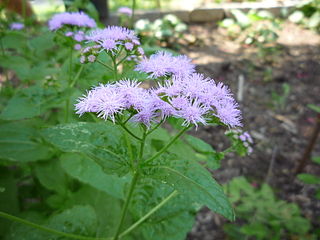
Conoclinium, the mistflowers, is a genus of four species of herbaceous perennial flowering plants, native to North America. They are 0.5 to 2 metres tall, and have blue to purple or violet flowers.

Ageratina herbacea is a North American species of flowering plants in the family Asteraceae known by the common names fragrant snakeroot and Apache snakeroot. It is native to desert regions of the southwestern United States and northern Mexico. It grows in rocky slopes in conifer forests and woodlands.

Ampelaster is a North American monotypic genus of flowering plants in the family Asteraceae. There is a single known species, Ampelaster carolinianus, with the common name of climbing aster. It is native to the southeastern United States, in the States of Florida, Georgia, North Carolina, and South Carolina.

Canadanthus is a North American monotypic genus of flowering plants in the family Asteraceae. The only species is Canadanthus modestus, commonly known as great northern aster or western bog aster. It is native to most of Canada and to northern parts of the United States.

Balsamorhiza incana is a North American species of plants in the tribe Heliantheae of the family Asteraceae. It is native to the northwestern United States, in Idaho, Montana, Wyoming, Washington, and Oregon.
Conoclinium mayfieldii is a Mexican species of flowering plants in the family Asteraceae. It has a discontinuous distribution, found in the Sierra Madre Occidental in Chihuahua and Durango, and also in the Sierra Madre Oriental in Tamaulipas. These two mountain ranges are separated by the Chihuahuan Desert, 400 km wide.

Conoclinium dissectum, the palm-leaf mistflower or palmleaf thoroughwort, is a North American species of flowering plants in the family Asteraceae. It is native to northern Mexico and the southwestern United States.
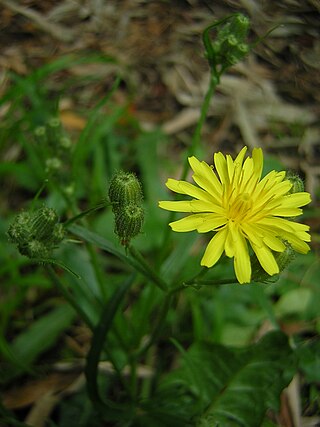
Crepis foetida is a European species of flowering plant in the family Asteraceae with the common name stinking hawksbeard. It is widespread across much of Europe and Siberia, as well as being sparingly naturalized in scattered locations in the United States and Australia.

Calyptocarpus vialis is a species of flowering plant in the family Asteraceae. Common names for C. vialis include straggler daisy, horseherb, lawnflower, and creeping Cinderella-weed. It is native to south Texas, Mexico, Belize, Venezuela, and the Caribbean. It has also been introduced east of Texas, Argentina, Hawaii, India, Java, Australia, and Taiwan. It is one of only three species in the genus Calyptocarpus.

Symphyotrichum racemosum is a species of flowering plant native to parts of the United States and introduced in Canada. It is known as smooth white oldfield aster and small white aster. It is a perennial, herbaceous plant in the family Asteraceae. It is a late-summer and fall blooming flower.

Symphyotrichum ciliatum is a species of flowering plant in the family Asteraceae native to North America and eastern Eurasia. Commonly known as rayless annual aster and rayless alkali aster, it is an annual, herbaceous plant that may reach over 70 centimeters in height. Each flower head has many whitish then pink disk florets and no ray florets ("rayless").
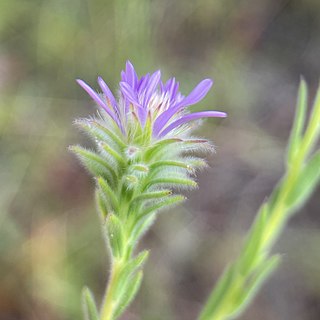
Symphyotrichum plumosum is a species of flowering plant in the family Asteraceae endemic to Florida in the United States. Commonly known as plumose aster, it is a perennial, herbaceous plant that may reach 40 to 100 centimeters tall. Its flowers have rose-purple ray florets and yellow turning to purple disk florets. It is of conservation concern.

Symphyotrichum undulatum is a species of flowering plant in the family Asteraceae native to eastern North America. Commonly known as wavyleaf aster, it is a perennial, herbaceous plant that flowers August through October and may reach heights between 30 and 160 centimeters.
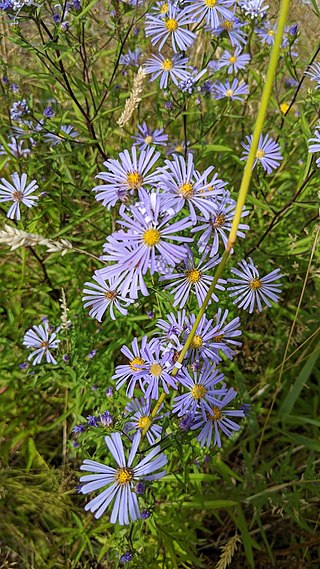
Symphyotrichum subspicatum is a species of flowering plant in the family Asteraceae native to western North America. Commonly known as Douglas's aster, it is a perennial, herbaceous plant that may reach 40 to 120 centimeters tall. Its flowers have violet ray florets and yellow then reddish disk florets.
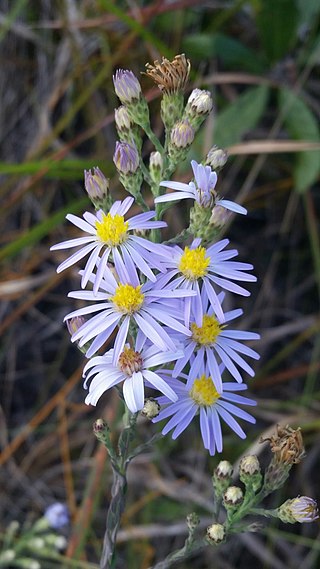
Symphyotrichum adnatum is a species of flowering plant in the family Asteraceae native to the southeastern United States and the Bahamas. Commonly known as scaleleaf aster, it is a perennial, herbaceous plant that may reach 30 to 120 centimeters tall. Its flowers have lavender ray florets and yellow disk florets.



















